
generative-ai-cdk-constructs
AWS Generative AI CDK Constructs are sample implementations of AWS CDK for common generative AI patterns.
Stars: 444
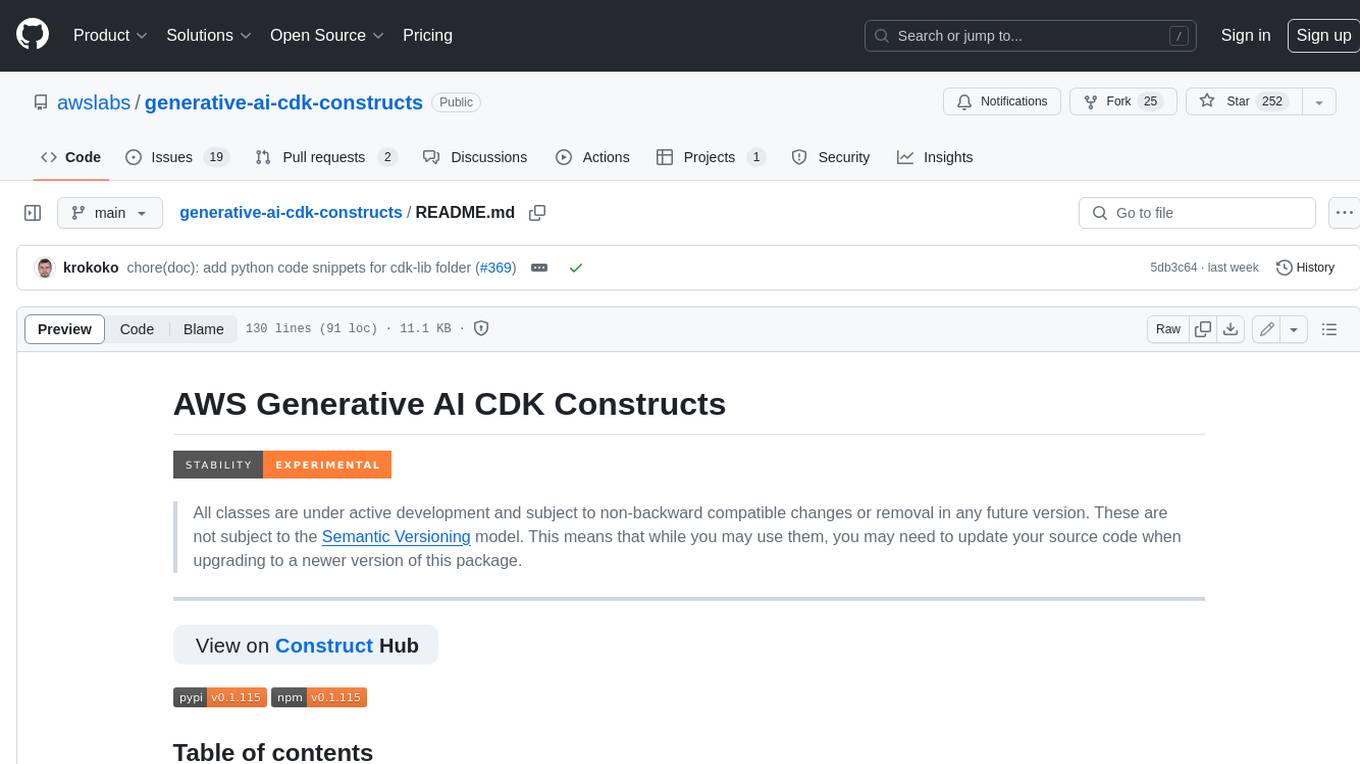
The AWS Generative AI Constructs Library is an open-source extension of the AWS Cloud Development Kit (AWS CDK) that provides multi-service, well-architected patterns for quickly defining solutions in code to create predictable and repeatable infrastructure, called constructs. The goal of AWS Generative AI CDK Constructs is to help developers build generative AI solutions using pattern-based definitions for their architecture. The patterns defined in AWS Generative AI CDK Constructs are high level, multi-service abstractions of AWS CDK constructs that have default configurations based on well-architected best practices. The library is organized into logical modules using object-oriented techniques to create each architectural pattern model.
README:
All classes are under active development and subject to non-backward compatible changes or removal in any future version. These are not subject to the Semantic Versioning model. This means that while you may use them, you may need to update your source code when upgrading to a newer version of this package.
- Introduction
- CDK Versions
- Contributing
- Design guidelines and Development guide
- Getting Started
- Catalog
- Sample Use Cases
- Additional Resources
- Contributors
- Operational Metrics Collection
- Roadmap
- Deprecation
- License
- Legal Disclaimer
The AWS Generative AI Constructs Library is an open-source extension of the AWS Cloud Development Kit (AWS CDK) that provides multi-service, well-architected patterns for quickly defining solutions in code to create predictable and repeatable infrastructure, called constructs. The goal of AWS Generative AI CDK Constructs is to help developers build generative AI solutions using pattern-based definitions for their architecture.
The patterns defined in AWS Generative AI CDK Constructs are high level, multi-service abstractions of AWS CDK constructs that have default configurations based on well-architected best practices. The library is organized into logical modules using object-oriented techniques to create each architectural pattern model.
AWS Generative AI CDK Constructs and the AWS CDK are independent teams and have different release schedules. Each release of AWS Generative AI CDK Constructs is built against a specific version of the AWS CDK. The CHANGELOG.md file lists the CDK version associated with each AWS Generative AI Constructs release. For instance, AWS Generative AI CDK Constructs v0.0.0 was built against AWS CDK v2.96.2. This means that to use AWS Generative AI CDK Constructs v0.0.0, your application must include AWS CDK v2.96.2 or later. You can continue to use the latest AWS CDK versions and upgrade the your AWS Generative AI CDK Constructs version when new releases become available.
Contributions of all kinds are welcome! Check out our contributor guide
If you want to add a new construct to the library, check out our design guidelines, then follow the development guide
TypeScript
- Create or use an existing CDK application in TypeScript.
cdk init app --language typescript
- Run
npm install @cdklabs/generative-ai-cdk-constructs - The package should be added to your package.json.
- Import the library:
import * as genai from '@cdklabs/generative-ai-cdk-constructs';
Python
- Create or use an existing CDK application in Python
cdk init app --language python
- Install the package:
pip install cdklabs.generative-ai-cdk-constructs
- Import the library:
import cdklabs.generative_ai_cdk_constructs
NuGet
- Create or use an existing CDK application in Python
cdk init app --language csharp
- Install the package while in the Visual Studio project:
dotnet add package CdkLabs.GenerativeAICdkConstructs
- Use the namespace:
using Cdklabs.GenerativeAiCdkConstructs;
Go
- Create or use an existing CDK application in Python
cdk init app --language go
- Get the module:
go get github.com/cdklabs/generative-ai-cdk-constructs-go/generative-ai-cdk-constructs
- Import the library:
import "github.com/cdklabs/generative-ai-cdk-constructs-go/generative-ai-cdk-constructs"
NOTE: The Go distribution repository, distributes the JSII tar gzipped versioned source from the source repository
Java
- Create or use an existing CDK application in Java
cdk init app --language java
- Add the dependency into the
pom.xml
<dependency>
<groupId>io.github.cdklabs</groupId>
<artifactId>generative-ai-cdk-constructs</artifactId>
<version>Get the latest version and insert it here</version>
</dependency>
Refer to the documentation for additional guidance on a particular construct: Catalog
The following constructs are available in the library:
| Construct | Description | AWS Services used |
|---|---|---|
| SageMaker model deployment (JumpStart) | Deploy a foundation model from Amazon SageMaker JumpStart to an Amazon SageMaker endpoint. | Amazon SageMaker |
| SageMaker model deployment (Hugging Face) | Deploy a foundation model from Hugging Face to an Amazon SageMaker endpoint. | Amazon SageMaker |
| SageMaker model deployment (Custom) | Deploy a foundation model from an S3 location to an Amazon SageMaker endpoint. | Amazon SageMaker |
| Amazon Bedrock Monitoring (Amazon CloudWatch Dashboard) | Amazon CloudWatch dashboard to monitor model usage from Amazon Bedrock. | Amazon CloudWatch |
| Bedrock Data Automation | Use Amazon bedrock data automation client to to build and manage intelligent document processing, media analysis, and other multimodal data-centric automation solutions | AWS Lambda, Amazon S3 bucket |
| Bedrock Batch Step Functions | Manage Bedrock model invocation jobs(batch inference) in AWS Step Functions state machines | AWS Step Functions, AWS Lambda, AWS EventBridge, Amazon Bedrock, AWS IAM |
| Construct | Description | AWS Services used |
|---|---|---|
| Amazon Bedrock | CDK L2 Constructs for Amazon Bedrock. | Amazon Bedrock, Amazon OpenSearch Serverless, AWS Lambda |
| Amazon OpenSearch Serverless Vector Collection | CDK L2 Constructs to create a vector collection. | Amazon OpenSearch Vector Index |
| Amazon OpenSearch Vector Index | CDK L1 Custom Resource to create a vector index. | Amazon OpenSearch Serverless, AWS Lambda |
The official samples repository includes a collection of functional use case implementations to demonstrate the usage of AWS Generative AI CDK Constructs. These can be used in the same way as architectural patterns, and can be conceptualized as an additional "higher-level" abstraction of those patterns. Those patterns (constructs) are composed together into stacks, forming a "CDK app".
| Resource | Type | Description |
|---|---|---|
| AWS re:Invent 2023 - Keynote with Dr. Werner Vogels | Keynote | Dr. Werner Vogels, Amazon.com's VP and CTO, announces the AWS Generative AI CDK Constructs during his AWS re:Invent 2023 keynote. |
| Workshop - Building Generative AI Apps on AWS with CDK | Workshop | In this workshop, you will explore how to build a sample generative AI app on AWS using CDK and Generative AI CDK Constructs. |
| Workshop - Hands on AWS CDK Generative AI Constructs | Workshop | In this workshop you will deploy projects that use CDK constructs from this library. Projects are from the amazon-bedrock-samples Github Repository. |
| Build generative AI applications with Amazon Titan Text Premier, Amazon Bedrock, and AWS CDK | Blog post + Code sample | Blog post exploring building and deploying two sample applications powered by Amazon Titan Text Premier using the Generative AI CDK constructs. |
| aws-cdk-stack-builder-tool | Code sample | AWS CDK Builder is a browser-based tool designed to streamline bootstrapping of Infrastructure as Code (IaC) projects using the AWS Cloud Development Kit (CDK). |
| CDK Live! Building generative AI applications and architectures leveraging AWS CDK Constructs! | Video | CDK Live! episode focused on building and deploying generative AI applications and architectures on AWS using the AWS Cloud Development Kit (CDK) and the AWS Generative AI CDK Constructs. |
| Announcing AWS Generative AI CDK Constructs! | Blog post | Blog post announcing the release of the AWS Generative AI CDK Constructs. |
| Streamline insurance underwriting with generative AI using Amazon Bedrock | Blog post + Code sample | Blog post and code sample discussing how to use AWS generative artificial intelligence (AI) solutions like Amazon Bedrock to improve the underwriting process, including rule validation, underwriting guidelines adherence, and decision justification. |
| aws-genai-llm-chatbot | Code sample | Multi-Model and Multi-RAG Powered Chatbot Using AWS CDK on AWS allowing you to experiment with a variety of Large Language Models and Multimodal Language Models, settings and prompts in your own AWS account. |
| bedrock-claude-chat | Code sample | AWS-native chatbot using Bedrock + Claude (+Mistral). |
| amazon-bedrock-rag | Code sample | Fully managed RAG solution using Knowledge Bases for Amazon Bedrock. |
| Amazon Bedrock Multimodal Search | Code sample | Multimodal product search app built using Amazon Titan Multimodal Embeddings model. |
| Amazon Bedrock Knowledge Bases with Private Data | Blog post + Code sample | Blog post and associated code sample demonstrating how to integrate Knowledge Bases into Amazon Bedrock to provide foundational models with contextual data from private data sources. |
| Automating tasks using Amazon Bedrock Agents and AI | Blog post + Code sample | Blog post and associated code sample demonstrating how to deploy an Amazon Bedrock Agent and a Knowledge Base through a hotel and spa use case. |
| Agents for Amazon Bedrock - Powertools for AWS Lambda (Python) | Code sample | Create Agents for Amazon Bedrock using event handlers and auto generation of OpenAPI schemas. |
| Text to SQL Bedrock Agent | Code sample | Harnessing the power of natural language processing, the "Text to SQL Bedrock Agent" facilitates the automatic transformation of natural language questions into executable SQL queries. |
| Dynamic Text-to-SQL for Enterprise Workloads with Amazon Bedrock Agent | Code sample | Elevate your data analysis with an end-to-end agentic Text-to-SQL solution, built on AWS for enterprise-scale adaptability and resilience. Ideal for complex scenarios like fraud detection in financial services. |
Generative AI CDK Constructs may collect anonymous operational metrics, including: the region a construct is deployed, the name and version of the construct deployed, and related information. We may use the metrics to maintain, provide, develop, and improve the constructs and AWS services.
Roadmap is available through the GitHub Project
To understand our deprecation process, please refer to the dedicated documentation
Apache-2.0
You should consider doing your own independent assessment before using the content in this library for production purposes. This may include (amongst other things) testing, securing, and optimizing the CDK constructs and other content, provided in this library, based on your specific quality control practices and standards.
© Copyright Amazon.com, Inc. or its affiliates. All Rights Reserved.
For Tasks:
Click tags to check more tools for each tasksFor Jobs:
Alternative AI tools for generative-ai-cdk-constructs
Similar Open Source Tools

generative-ai-cdk-constructs
The AWS Generative AI Constructs Library is an open-source extension of the AWS Cloud Development Kit (AWS CDK) that provides multi-service, well-architected patterns for quickly defining solutions in code to create predictable and repeatable infrastructure, called constructs. The goal of AWS Generative AI CDK Constructs is to help developers build generative AI solutions using pattern-based definitions for their architecture. The patterns defined in AWS Generative AI CDK Constructs are high level, multi-service abstractions of AWS CDK constructs that have default configurations based on well-architected best practices. The library is organized into logical modules using object-oriented techniques to create each architectural pattern model.
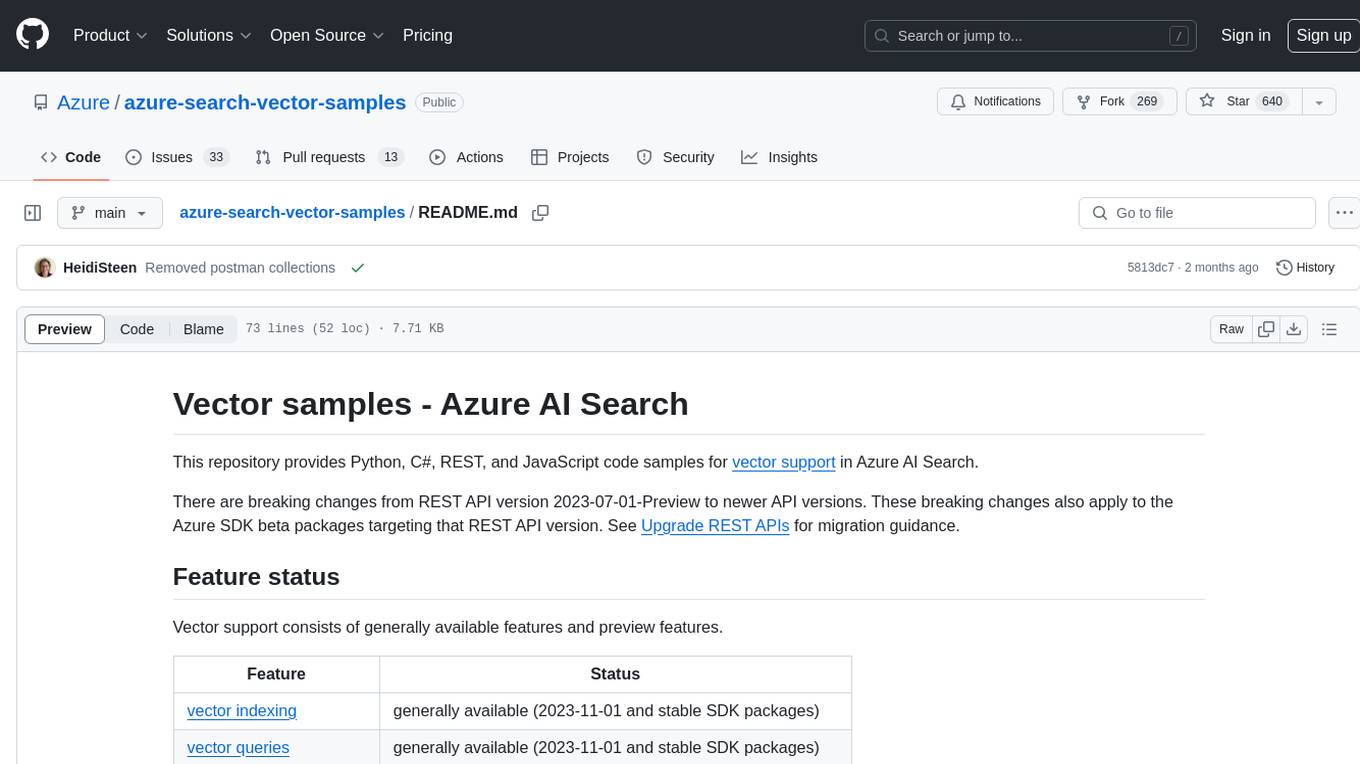
azure-search-vector-samples
This repository provides code samples in Python, C#, REST, and JavaScript for vector support in Azure AI Search. It includes demos for various languages showcasing vectorization of data, creating indexes, and querying vector data. Additionally, it offers tools like Azure AI Search Lab for experimenting with AI-enabled search scenarios in Azure and templates for deploying custom chat-with-your-data solutions. The repository also features documentation on vector search, hybrid search, creating and querying vector indexes, and REST API references for Azure AI Search and Azure OpenAI Service.
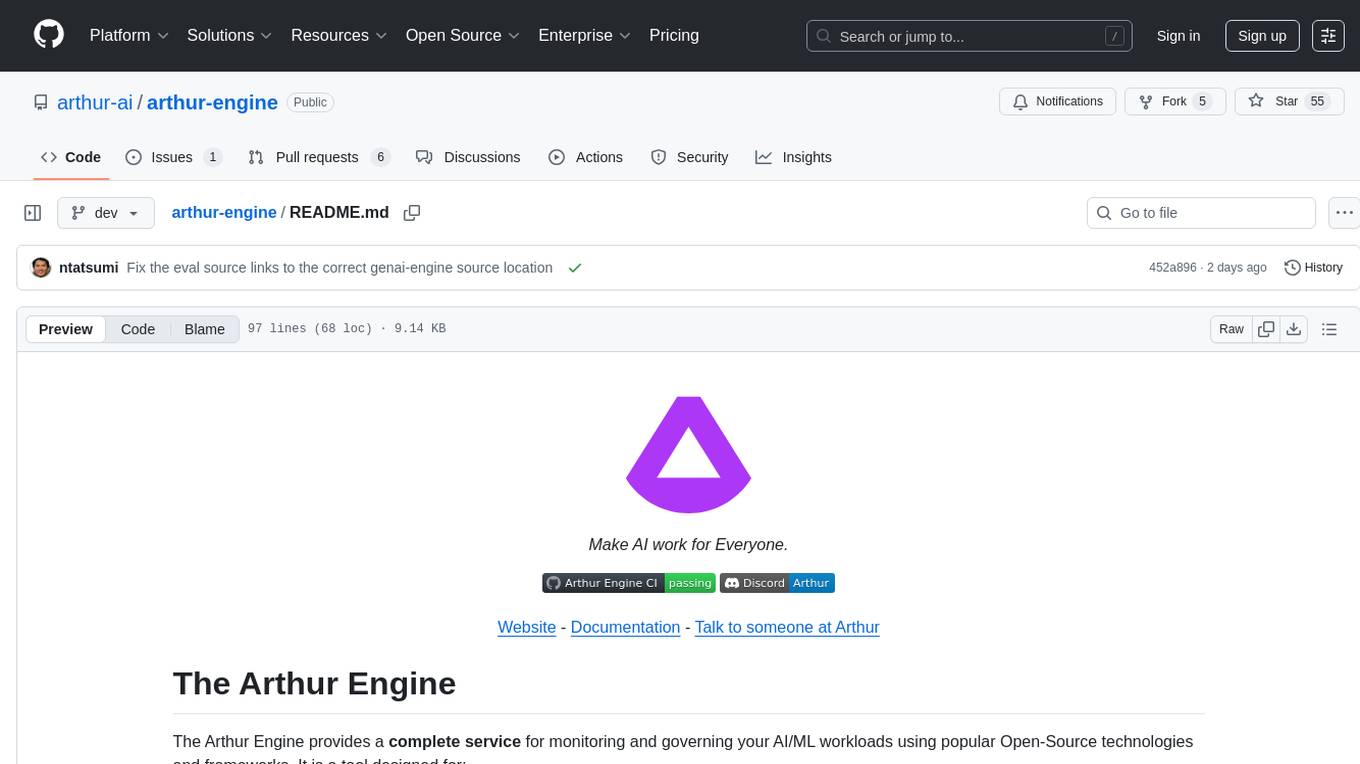
arthur-engine
The Arthur Engine is a comprehensive tool for monitoring and governing AI/ML workloads. It provides evaluation and benchmarking of machine learning models, guardrails enforcement, and extensibility for fitting into various application architectures. With support for a wide range of evaluation metrics and customizable features, the tool aims to improve model understanding, optimize generative AI outputs, and prevent data-security and compliance risks. Key features include real-time guardrails, model performance monitoring, feature importance visualization, error breakdowns, and support for custom metrics and models integration.
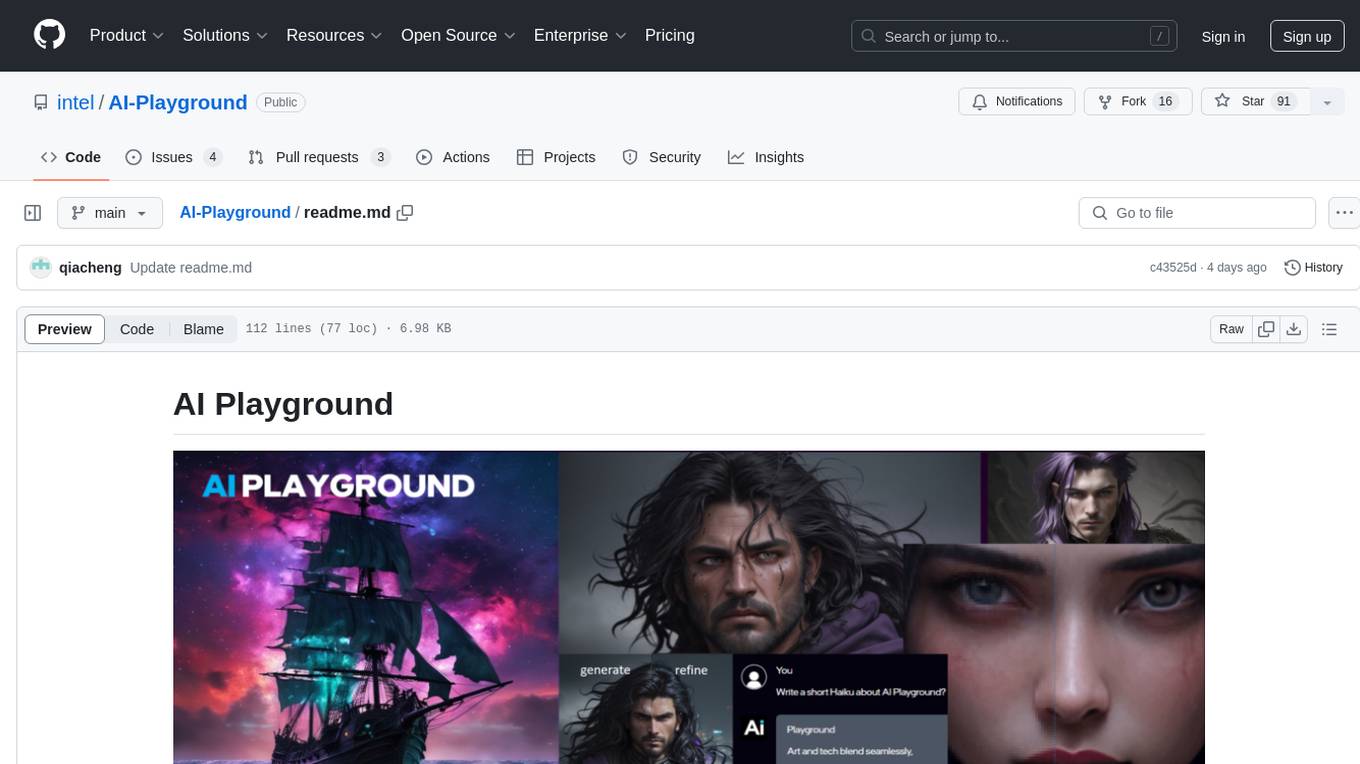
AI-Playground
AI Playground is an open-source project and AI PC starter app designed for AI image creation, image stylizing, and chatbot functionalities on a PC powered by an Intel Arc GPU. It leverages libraries from GitHub and Huggingface, providing users with the ability to create AI-generated content and interact with chatbots. The tool requires specific hardware specifications and offers packaged installers for ease of setup. Users can also develop the project environment, link it to the development environment, and utilize alternative models for different AI tasks.

fenic
fenic is an opinionated DataFrame framework from typedef.ai for building AI and agentic applications. It transforms unstructured and structured data into insights using familiar DataFrame operations enhanced with semantic intelligence. With support for markdown, transcripts, and semantic operators, plus efficient batch inference across various model providers. fenic is purpose-built for LLM inference, providing a query engine designed for AI workloads, semantic operators as first-class citizens, native unstructured data support, production-ready infrastructure, and a familiar DataFrame API.
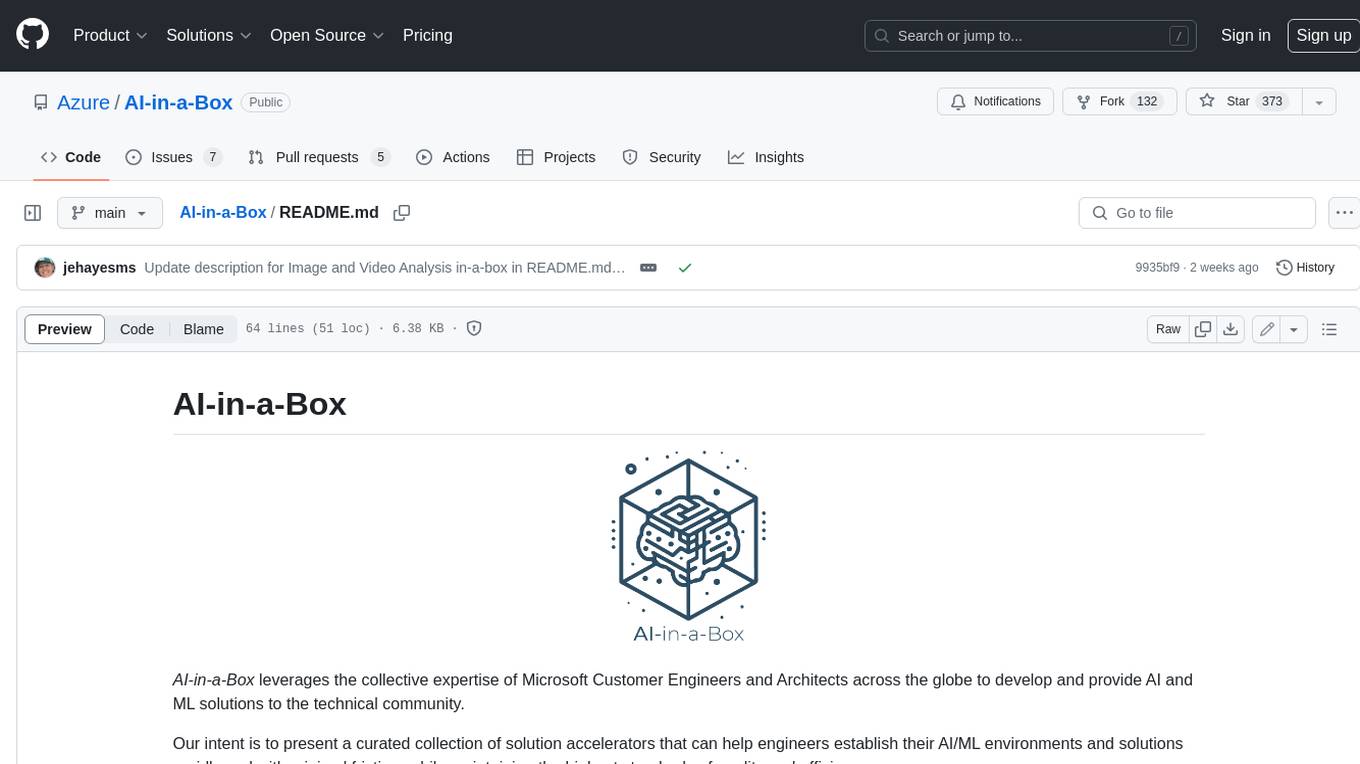
AI-in-a-Box
AI-in-a-Box is a curated collection of solution accelerators that can help engineers establish their AI/ML environments and solutions rapidly and with minimal friction, while maintaining the highest standards of quality and efficiency. It provides essential guidance on the responsible use of AI and LLM technologies, specific security guidance for Generative AI (GenAI) applications, and best practices for scaling OpenAI applications within Azure. The available accelerators include: Azure ML Operationalization in-a-box, Edge AI in-a-box, Doc Intelligence in-a-box, Image and Video Analysis in-a-box, Cognitive Services Landing Zone in-a-box, Semantic Kernel Bot in-a-box, NLP to SQL in-a-box, Assistants API in-a-box, and Assistants API Bot in-a-box.
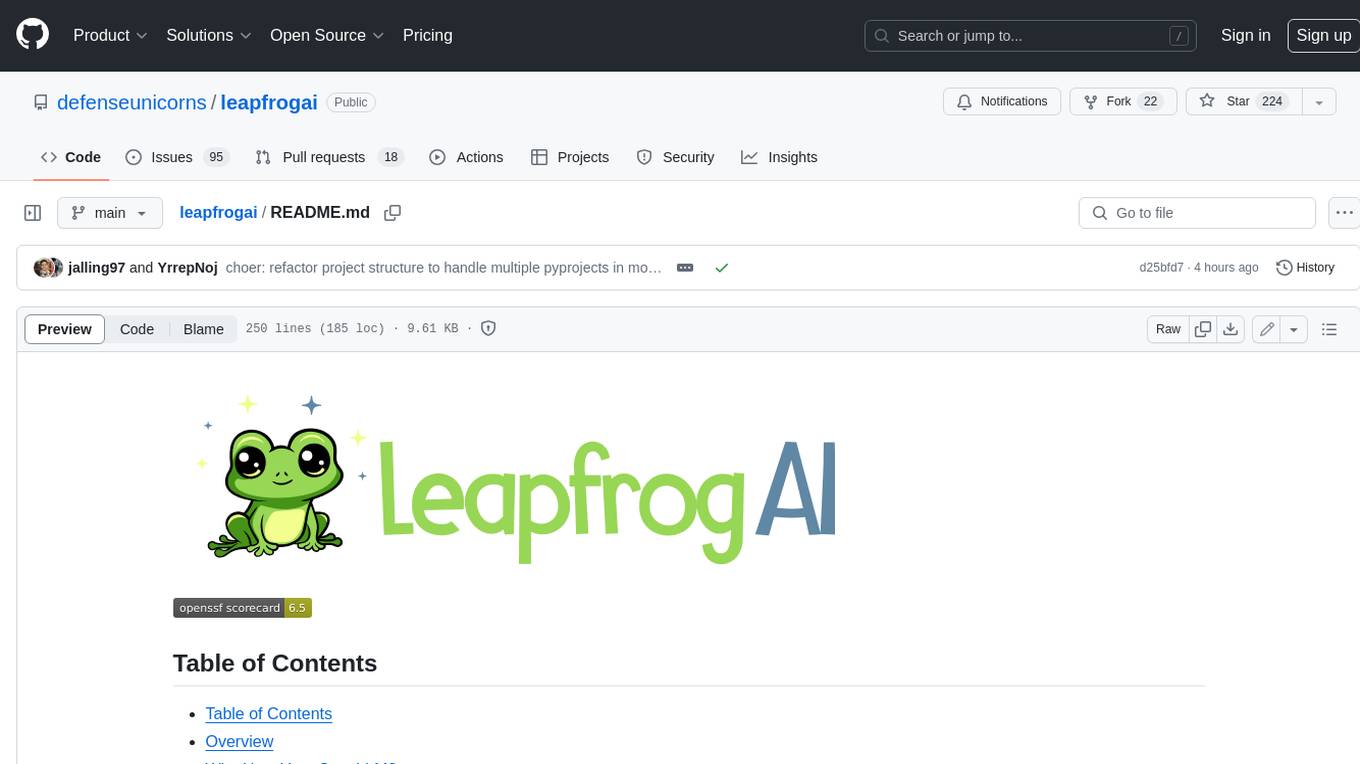
leapfrogai
LeapfrogAI is a self-hosted AI platform designed to be deployed in air-gapped resource-constrained environments. It brings sophisticated AI solutions to these environments by hosting all the necessary components of an AI stack, including vector databases, model backends, API, and UI. LeapfrogAI's API closely matches that of OpenAI, allowing tools built for OpenAI/ChatGPT to function seamlessly with a LeapfrogAI backend. It provides several backends for various use cases, including llama-cpp-python, whisper, text-embeddings, and vllm. LeapfrogAI leverages Chainguard's apko to harden base python images, ensuring the latest supported Python versions are used by the other components of the stack. The LeapfrogAI SDK provides a standard set of protobuffs and python utilities for implementing backends and gRPC. LeapfrogAI offers UI options for common use-cases like chat, summarization, and transcription. It can be deployed and run locally via UDS and Kubernetes, built out using Zarf packages. LeapfrogAI is supported by a community of users and contributors, including Defense Unicorns, Beast Code, Chainguard, Exovera, Hypergiant, Pulze, SOSi, United States Navy, United States Air Force, and United States Space Force.
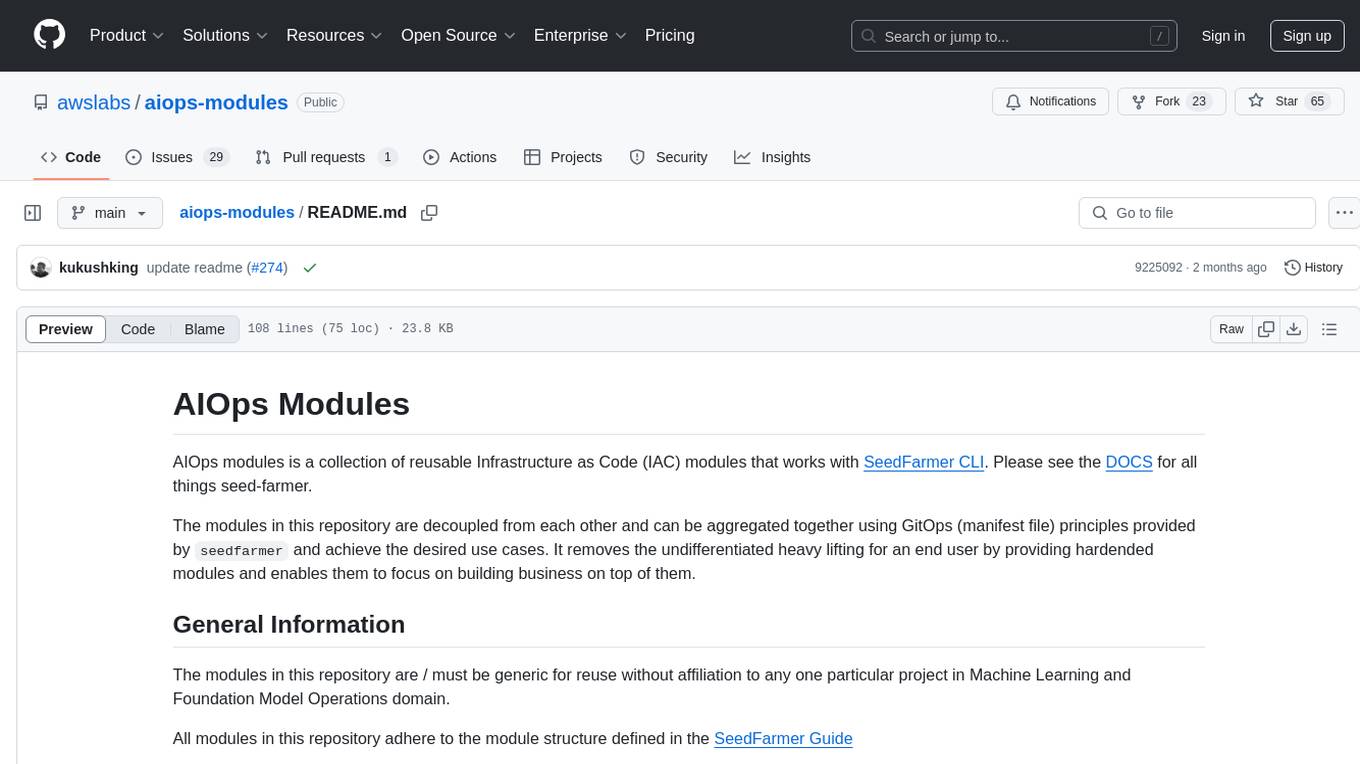
aiops-modules
AIOps Modules is a collection of reusable Infrastructure as Code (IAC) modules that work with SeedFarmer CLI. The modules are decoupled and can be aggregated using GitOps principles to achieve desired use cases, removing heavy lifting for end users. They must be generic for reuse in Machine Learning and Foundation Model Operations domain, adhering to SeedFarmer Guide structure. The repository includes deployment steps, project manifests, and various modules for SageMaker, Mlflow, FMOps/LLMOps, MWAA, Step Functions, EKS, and example use cases. It also supports Industry Data Framework (IDF) and Autonomous Driving Data Framework (ADDF) Modules.

OmAgent
OmAgent is an open-source agent framework designed to streamline the development of on-device multimodal agents. It enables agents to empower various hardware devices, integrates speed-optimized SOTA multimodal models, provides SOTA multimodal agent algorithms, and focuses on optimizing the end-to-end computing pipeline for real-time user interaction experience. Key features include easy connection to diverse devices, scalability, flexibility, and workflow orchestration. The architecture emphasizes graph-based workflow orchestration, native multimodality, and device-centricity, allowing developers to create bespoke intelligent agent programs.
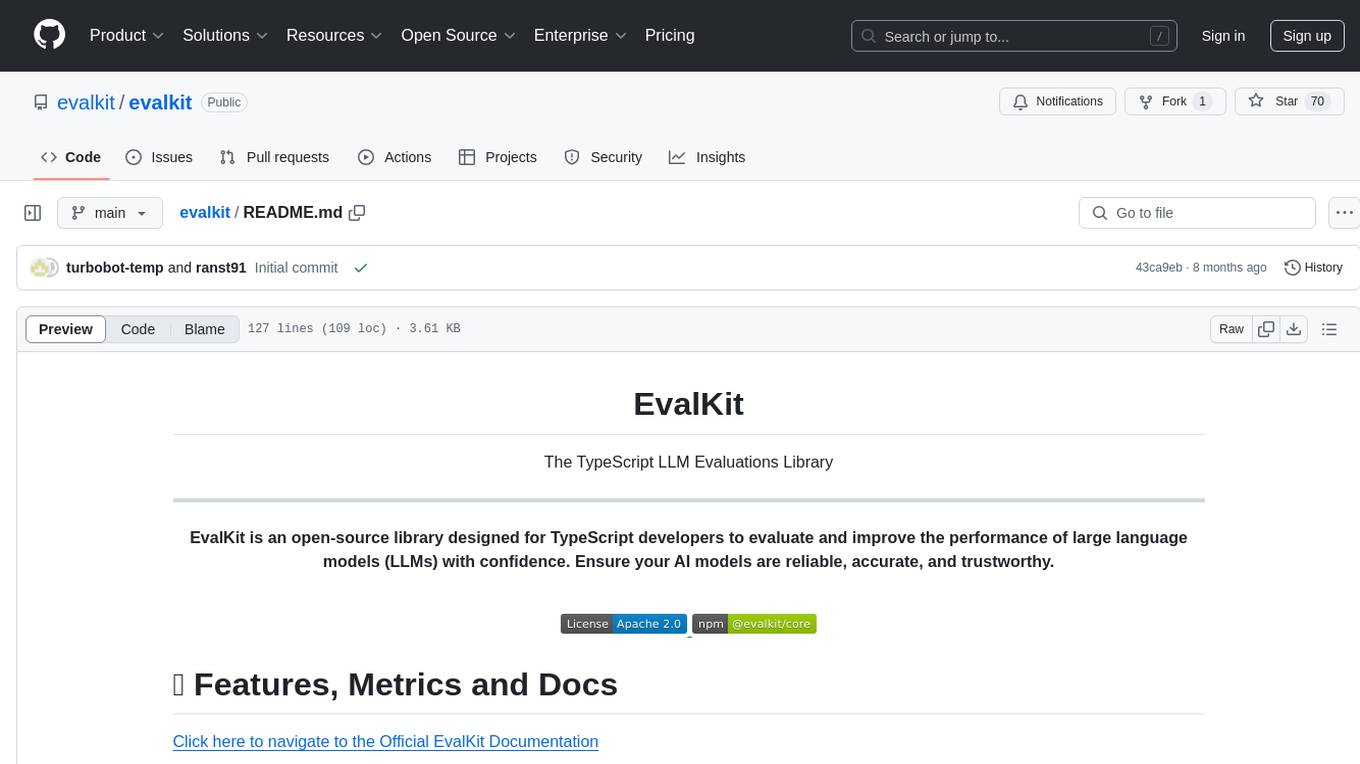
evalkit
EvalKit is an open-source TypeScript library for evaluating and improving the performance of large language models (LLMs). It helps developers ensure the reliability, accuracy, and trustworthiness of their AI models. The library provides various metrics such as Bias Detection, Coherence, Faithfulness, Hallucination, Intent Detection, and Semantic Similarity. EvalKit is designed to be user-friendly with detailed documentation, tutorials, and recipes for different use cases and LLM providers. It requires Node.js 18+ and an OpenAI API Key for installation and usage. Contributions from the community are welcome under the Apache 2.0 License.
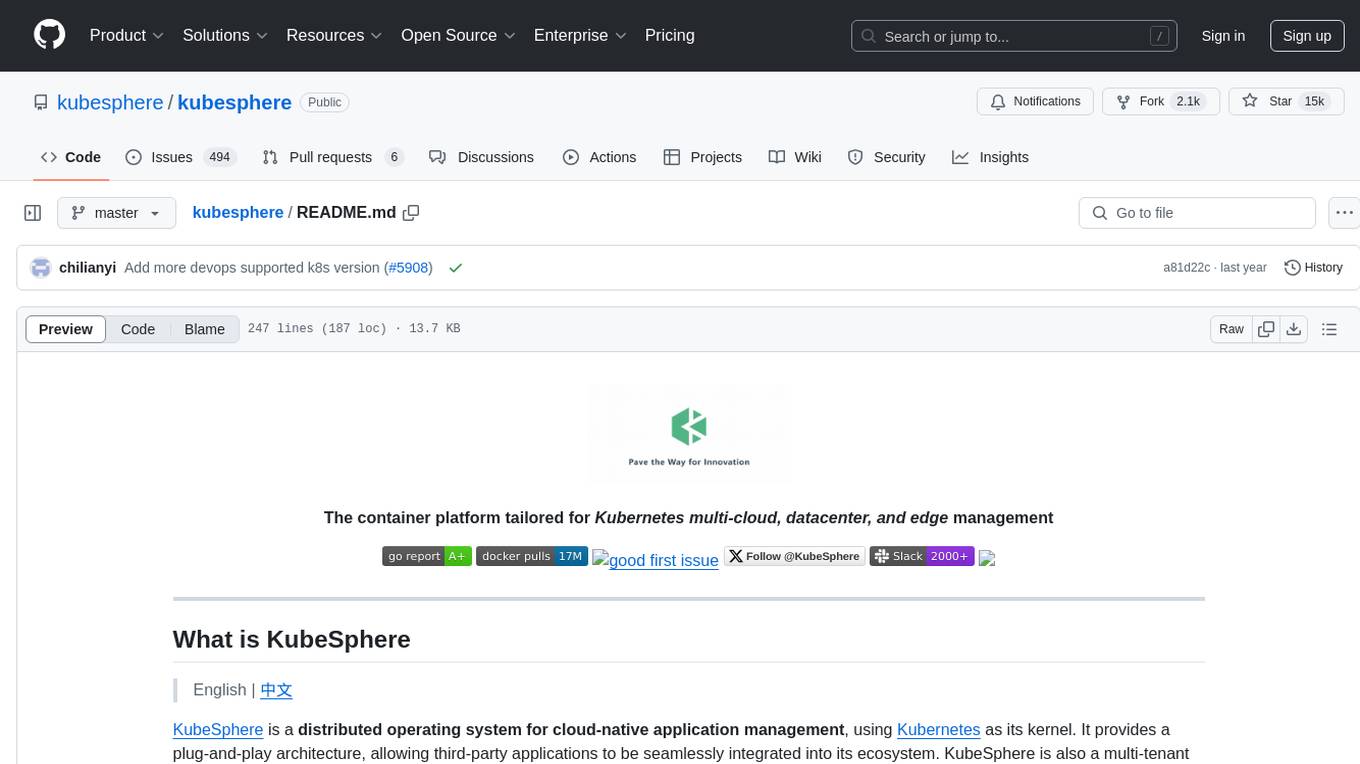
kubesphere
KubeSphere is a distributed operating system for cloud-native application management, using Kubernetes as its kernel. It provides a plug-and-play architecture, allowing third-party applications to be seamlessly integrated into its ecosystem. KubeSphere is also a multi-tenant container platform with full-stack automated IT operation and streamlined DevOps workflows. It provides developer-friendly wizard web UI, helping enterprises to build out a more robust and feature-rich platform, which includes most common functionalities needed for enterprise Kubernetes strategy.

qlib
Qlib is an open-source, AI-oriented quantitative investment platform that supports diverse machine learning modeling paradigms, including supervised learning, market dynamics modeling, and reinforcement learning. It covers the entire chain of quantitative investment, from alpha seeking to order execution. The platform empowers researchers to explore ideas and implement productions using AI technologies in quantitative investment. Qlib collaboratively solves key challenges in quantitative investment by releasing state-of-the-art research works in various paradigms. It provides a full ML pipeline for data processing, model training, and back-testing, enabling users to perform tasks such as forecasting market patterns, adapting to market dynamics, and modeling continuous investment decisions.

katib
Katib is a Kubernetes-native project for automated machine learning (AutoML). Katib supports Hyperparameter Tuning, Early Stopping and Neural Architecture Search. Katib is the project which is agnostic to machine learning (ML) frameworks. It can tune hyperparameters of applications written in any language of the users’ choice and natively supports many ML frameworks, such as TensorFlow, Apache MXNet, PyTorch, XGBoost, and others. Katib can perform training jobs using any Kubernetes Custom Resources with out of the box support for Kubeflow Training Operator, Argo Workflows, Tekton Pipelines and many more.

mlcraft
Synmetrix (prev. MLCraft) is an open source data engineering platform and semantic layer for centralized metrics management. It provides a complete framework for modeling, integrating, transforming, aggregating, and distributing metrics data at scale. Key features include data modeling and transformations, semantic layer for unified data model, scheduled reports and alerts, versioning, role-based access control, data exploration, caching, and collaboration on metrics modeling. Synmetrix leverages Cube (Cube.js) for flexible data models that consolidate metrics from various sources, enabling downstream distribution via a SQL API for integration into BI tools, reporting, dashboards, and data science. Use cases include data democratization, business intelligence, embedded analytics, and enhancing accuracy in data handling and queries. The tool speeds up data-driven workflows from metrics definition to consumption by combining data engineering best practices with self-service analytics capabilities.
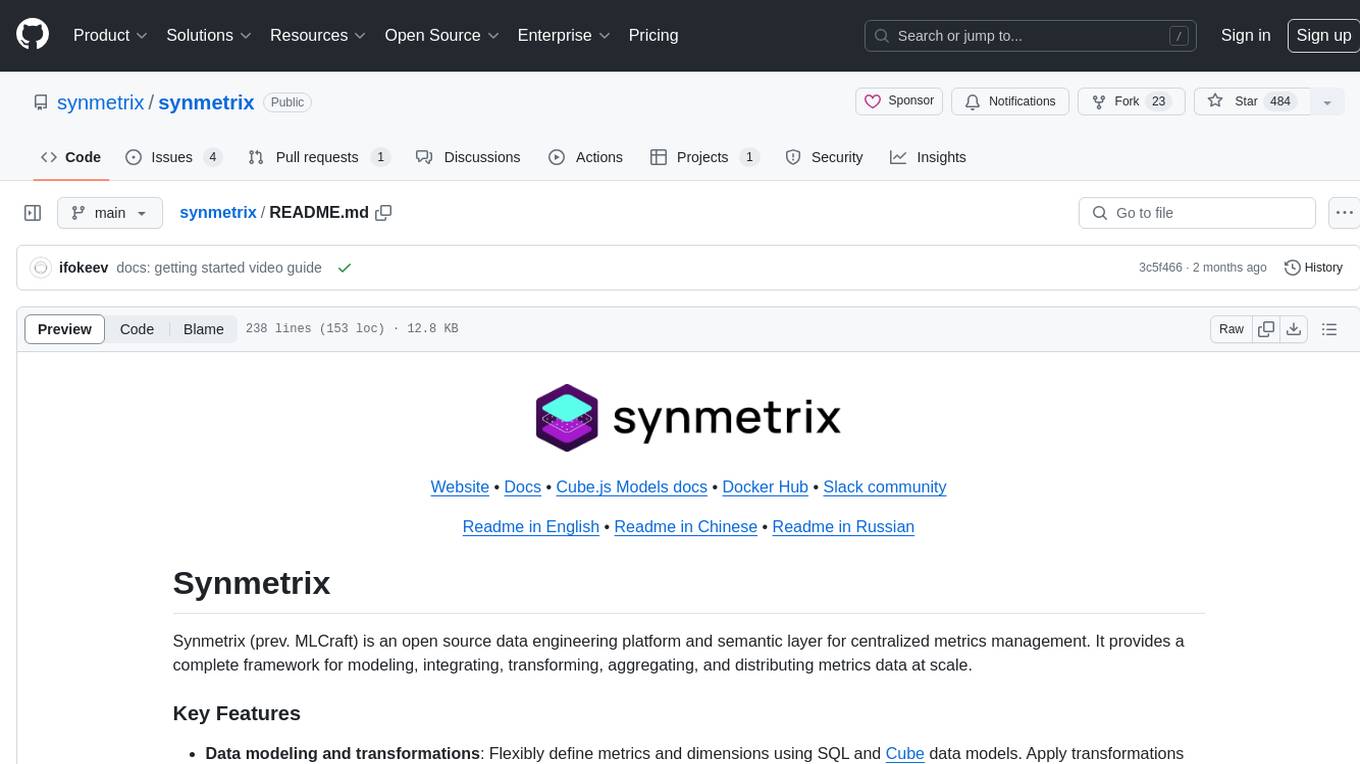
synmetrix
Synmetrix is an open source data engineering platform and semantic layer for centralized metrics management. It provides a complete framework for modeling, integrating, transforming, aggregating, and distributing metrics data at scale. Key features include data modeling and transformations, semantic layer for unified data model, scheduled reports and alerts, versioning, role-based access control, data exploration, caching, and collaboration on metrics modeling. Synmetrix leverages Cube.js to consolidate metrics from various sources and distribute them downstream via a SQL API. Use cases include data democratization, business intelligence and reporting, embedded analytics, and enhancing accuracy in data handling and queries. The tool speeds up data-driven workflows from metrics definition to consumption by combining data engineering best practices with self-service analytics capabilities.

training-operator
Kubeflow Training Operator is a Kubernetes-native project for fine-tuning and scalable distributed training of machine learning (ML) models created with various ML frameworks such as PyTorch, Tensorflow, XGBoost, MPI, Paddle and others. Training Operator allows you to use Kubernetes workloads to effectively train your large models via Kubernetes Custom Resources APIs or using Training Operator Python SDK. > Note: Before v1.2 release, Kubeflow Training Operator only supports TFJob on Kubernetes. * For a complete reference of the custom resource definitions, please refer to the API Definition. * TensorFlow API Definition * PyTorch API Definition * Apache MXNet API Definition * XGBoost API Definition * MPI API Definition * PaddlePaddle API Definition * For details of all-in-one operator design, please refer to the All-in-one Kubeflow Training Operator * For details on its observability, please refer to the monitoring design doc.
For similar tasks

generative-ai-cdk-constructs
The AWS Generative AI Constructs Library is an open-source extension of the AWS Cloud Development Kit (AWS CDK) that provides multi-service, well-architected patterns for quickly defining solutions in code to create predictable and repeatable infrastructure, called constructs. The goal of AWS Generative AI CDK Constructs is to help developers build generative AI solutions using pattern-based definitions for their architecture. The patterns defined in AWS Generative AI CDK Constructs are high level, multi-service abstractions of AWS CDK constructs that have default configurations based on well-architected best practices. The library is organized into logical modules using object-oriented techniques to create each architectural pattern model.
For similar jobs
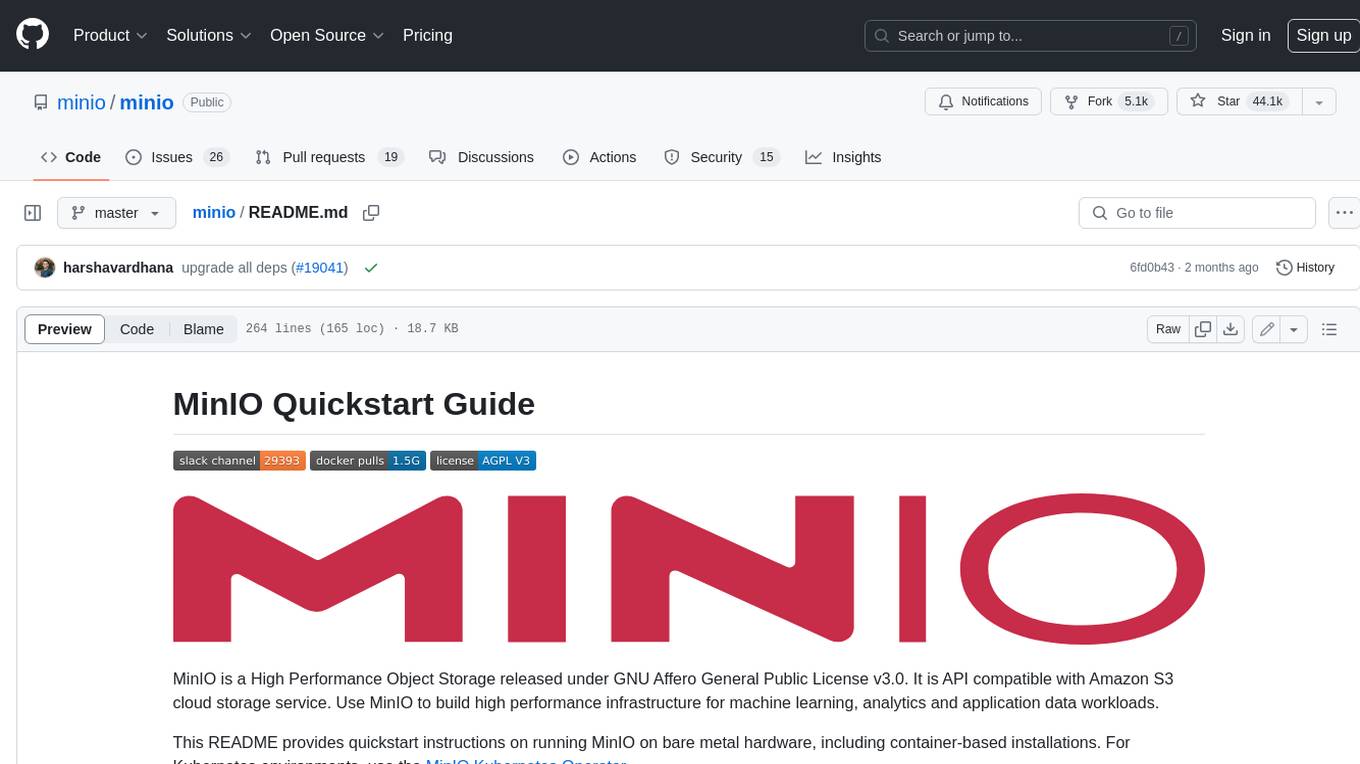
minio
MinIO is a High Performance Object Storage released under GNU Affero General Public License v3.0. It is API compatible with Amazon S3 cloud storage service. Use MinIO to build high performance infrastructure for machine learning, analytics and application data workloads.
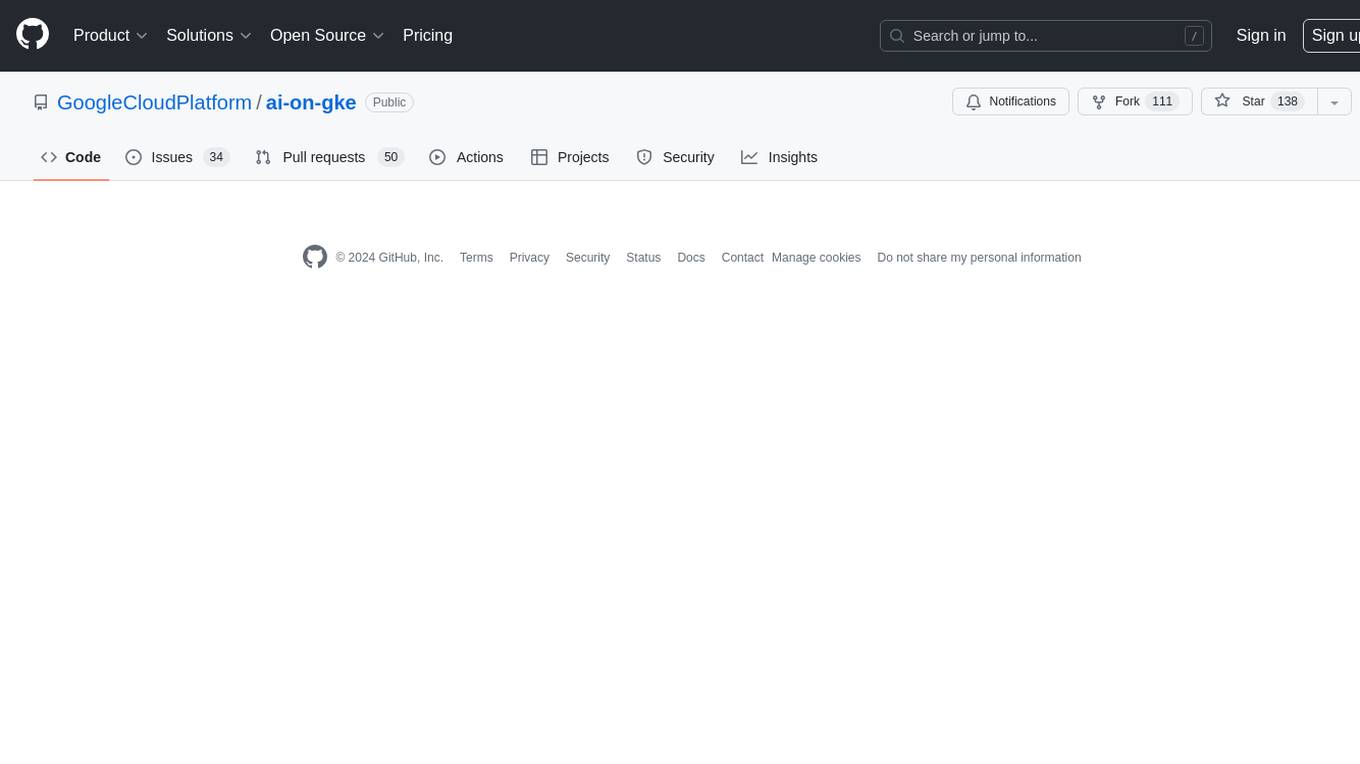
ai-on-gke
This repository contains assets related to AI/ML workloads on Google Kubernetes Engine (GKE). Run optimized AI/ML workloads with Google Kubernetes Engine (GKE) platform orchestration capabilities. A robust AI/ML platform considers the following layers: Infrastructure orchestration that support GPUs and TPUs for training and serving workloads at scale Flexible integration with distributed computing and data processing frameworks Support for multiple teams on the same infrastructure to maximize utilization of resources

kong
Kong, or Kong API Gateway, is a cloud-native, platform-agnostic, scalable API Gateway distinguished for its high performance and extensibility via plugins. It also provides advanced AI capabilities with multi-LLM support. By providing functionality for proxying, routing, load balancing, health checking, authentication (and more), Kong serves as the central layer for orchestrating microservices or conventional API traffic with ease. Kong runs natively on Kubernetes thanks to its official Kubernetes Ingress Controller.

AI-in-a-Box
AI-in-a-Box is a curated collection of solution accelerators that can help engineers establish their AI/ML environments and solutions rapidly and with minimal friction, while maintaining the highest standards of quality and efficiency. It provides essential guidance on the responsible use of AI and LLM technologies, specific security guidance for Generative AI (GenAI) applications, and best practices for scaling OpenAI applications within Azure. The available accelerators include: Azure ML Operationalization in-a-box, Edge AI in-a-box, Doc Intelligence in-a-box, Image and Video Analysis in-a-box, Cognitive Services Landing Zone in-a-box, Semantic Kernel Bot in-a-box, NLP to SQL in-a-box, Assistants API in-a-box, and Assistants API Bot in-a-box.

awsome-distributed-training
This repository contains reference architectures and test cases for distributed model training with Amazon SageMaker Hyperpod, AWS ParallelCluster, AWS Batch, and Amazon EKS. The test cases cover different types and sizes of models as well as different frameworks and parallel optimizations (Pytorch DDP/FSDP, MegatronLM, NemoMegatron...).

generative-ai-cdk-constructs
The AWS Generative AI Constructs Library is an open-source extension of the AWS Cloud Development Kit (AWS CDK) that provides multi-service, well-architected patterns for quickly defining solutions in code to create predictable and repeatable infrastructure, called constructs. The goal of AWS Generative AI CDK Constructs is to help developers build generative AI solutions using pattern-based definitions for their architecture. The patterns defined in AWS Generative AI CDK Constructs are high level, multi-service abstractions of AWS CDK constructs that have default configurations based on well-architected best practices. The library is organized into logical modules using object-oriented techniques to create each architectural pattern model.

model_server
OpenVINO™ Model Server (OVMS) is a high-performance system for serving models. Implemented in C++ for scalability and optimized for deployment on Intel architectures, the model server uses the same architecture and API as TensorFlow Serving and KServe while applying OpenVINO for inference execution. Inference service is provided via gRPC or REST API, making deploying new algorithms and AI experiments easy.

dify-helm
Deploy langgenius/dify, an LLM based chat bot app on kubernetes with helm chart.









